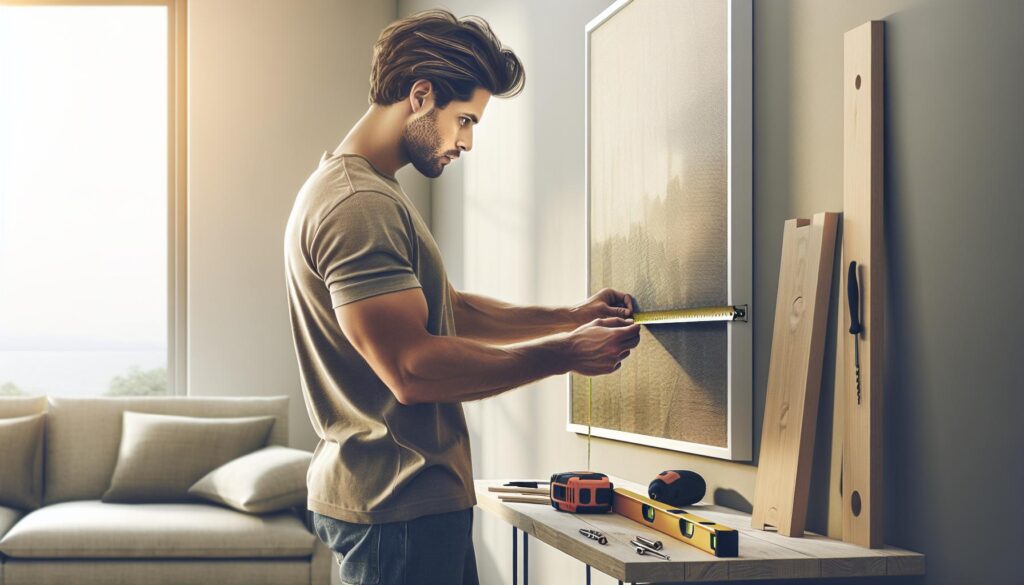Hanging heavy pictures can seem daunting, but with the right techniques, it’s a straightforward task. Many people love to showcase their favorite artwork or family portraits, and ensuring they’re securely mounted is crucial for both aesthetics and safety. Using wire for hanging adds a level of flexibility and stability that traditional methods may lack.
Understanding how to properly use wire will not only enhance the look of your space but also protect your prized possessions. From selecting the right materials to mastering the installation process, this guide will walk through the essential steps to hang heavy pictures with confidence. Whether you’re a seasoned DIY enthusiast or just starting, these tips will help turn your wall into a stunning gallery.
How to Hang A Heavy Picture With Wire
Gathering the right tools and materials simplifies hanging heavy pictures securely. Below are the essential items required for the task.
Essential Tools
- Stud Finder: Detects wall studs for secure anchor placement.
- Level: Ensures the picture hangs straight.
- Drill: Drills holes for anchors or screws.
- Screwdriver: Tightens screws for brackets or anchors.
- Hammer: Assists in driving in nails or tapping anchors.
- Measuring Tape: Measures distances for accurate positioning.
- Pencil: Marks spots on the wall for reference.
- Picture Wire: Provides flexibility and strength; usually made of stainless steel or heavy-duty nylon.
- Wall Anchors: Supports heavy frames; toggles or expansions are common types.
- Screws: Compatible with wall anchors for secure attachment.
- Brackets: Utilized for additional support, especially for larger frames.
- D-Rings or Eye Hooks: Attach to the back of the picture frame for hanging.
- Safety Hangers: Offer extra stability and minimize the risk of falling.
These tools and materials create a robust framework for hanging heavy pictures effectively.
Preparing the Wall

Preparing the wall is crucial for securely hanging heavy pictures. Proper location selection and wall stability checks ensure safety and longevity of the installation.
Choosing the Right Location
Selecting the ideal spot for hanging a heavy picture involves various considerations. Identify focal points in the room, such as above furniture or on prominent wall spaces. Ensure that the chosen location complements the overall décor. Measure the height and width of the picture to align it proportionately with the surrounding elements. Avoid areas with excessive sunlight or moisture exposure, as these can damage artwork over time.
Checking Wall Stability
Ensuring wall stability prevents accidents and damage to both the picture and the wall. Use a stud finder to locate wall studs, as mounting into these provides the strongest support. Test the wall for weaknesses by applying gentle pressure to check for movement or sagging. If necessary, use wall anchors designed for heavy loads if studs are not available. Checking for any electrical wiring or plumbing within the wall is essential before drilling to prevent hazardous situations.
Installing the Picture Wire
Installing the picture wire correctly is vital for securely hanging heavy pictures. This process involves precise attachment and measuring to ensure stability.
Attaching the Wire to the Frame
Attaching the wire to the frame requires a few simple steps. First, locate the D-rings or eye hooks on the back of the frame. Position them on opposite sides, about one-third down from the top. Next, use screws to secure the D-rings or eye hooks firmly into the frame. Then, thread the picture wire through each D-ring or eye hook, leaving a few inches extra for flexibility. Finally, wrap the wire around itself several times to create a strong hold, ensuring to leave enough slack for easy hanging.
Preparing the Wire Length
Preparing the wire length is crucial for optimal hanging. Measure the distance between the D-rings or eye hooks on the back of the frame. Multiply this measurement by two to account for the wire needed on each side. Add an additional 12 inches to allow for wrapping and adjustments. Cut the wire using wire cutters to achieve the desired length, ensuring a clean, even cut. This preparation ensures the wire is long enough to support the picture securely while allowing for adjustability during installation.
Hanging the Picture
Hanging a heavy picture requires precision for stability and aesthetics. Follow these detailed steps to ensure a secure display.
Marking the Wall for Placement
Marking the wall accurately is essential for proper picture alignment. First, determine the desired height for the picture’s midpoint, usually at eye level. Use a measuring tape to measure this height from the floor.
Next, use a level to ensure accurate placement. For a straight line, extend a light pencil marking across the wall to indicate where the top edge of the frame will align. If using multiple pictures, space them evenly by measuring the desired distance between frames.
Attaching the Picture to the Wall
Attaching the picture securely involves several key steps. Start by inserting wall anchors or screws into the marked spots, depending on the wall type and weight of the picture. If mounting directly into a stud, use screws suitable for the stud’s type and size.
After securing the anchors or screws, hook the picture wire onto the hardware, ensuring it sits firmly without slack. Adjust the picture to align with the desired height. Finally, step back to verify the picture is level and visually appealing.
Safety Tips
Safety is crucial when hanging heavy pictures. Adopting proper practices prevents accidents and damage, ensuring a secure and stable display.
Ensuring Proper Weight Support
Ensure the wall, anchors, and hardware can support the picture’s weight. Use wall anchors rated for the picture’s weight, selecting appropriate materials like metal or toggle bolts for heavier frames. Check that the designated wall stud can handle the load, as drywall alone may not suffice. For added security, use multiple anchors or screws for larger pictures to distribute weight evenly.
Avoiding Common Mistakes
Avoid common mistakes by double-checking all measurements and materials. Don’t assume all wall types or anchors have the same load-bearing capacity; verify specifications. Avoid hanging pictures directly over furniture without appropriate clearance, as this increases the risk of accidents. Don’t neglect to level the picture to ensure proper alignment. When in doubt, consult resources or professionals to mitigate errors that compromise safety.
Hanging heavy pictures with wire doesn’t have to be daunting. By following the right techniques and using the appropriate tools and materials, anyone can achieve a secure and visually pleasing display. Careful preparation and attention to detail are crucial for ensuring both safety and aesthetics.
Taking the time to select the right location and checking wall stability can prevent future issues. With the steps outlined in this guide, readers can confidently transform their walls into stunning galleries while avoiding common pitfalls. Embracing these practices will not only enhance the beauty of their spaces but also provide peace of mind knowing their artwork is safely mounted.
